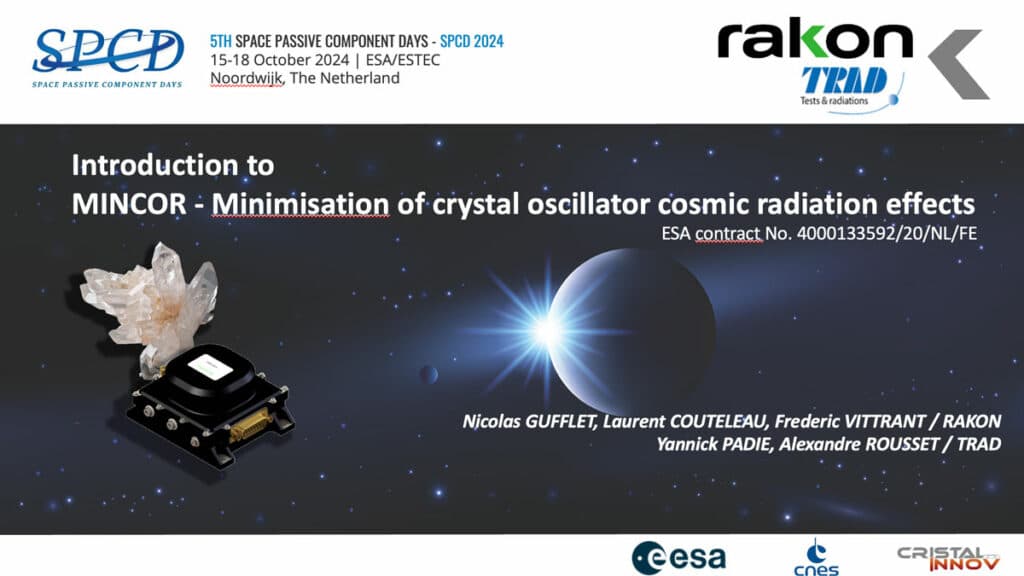This paper MINCOR – Minimization Of Crystal Oscillator Cosmic Radiation Effects was prepared by Nicolas GUFFLET, Laurent COUTELEAU, Frederic VITTRANT / RAKON Yannick PADIE, Alexandre ROUSSET / TRAD and presented during the 5th Space Passive Component Days (SPCD), an International Symposium held from October 15th to 18th, 2024, at ESA/ESTEC in Noordwijk, the Netherlands. Published under permission from ESA SPCD organizers.
Introduction:
The MINCOR project, funded by the European Space Agency (ESA), aims to mitigate the effects of cosmic radiation on quartz crystal oscillators used in space applications.
These oscillators are vital for navigation systems, telecommunications, and scientific instruments due to their exceptional frequency stability and signal purity.
However, space environments expose them to ionizing radiation, which can lead to frequency drifts. The project seeks to balance performance needs with cost-efficiency, particularly for low Earth orbit (LEO) satellites under the New Space paradigm.
Key Points:
- Objective: Reduce radiation sensitivity of quartz crystal oscillators.
- Project Partners: RAKON France and TRAD.
- Target Applications: Navigation systems, telecom satellites, and scientific missions.
- Challenges: Managing total ionizing dose (TID) and non-ionizing energy loss (NIEL) effects.
- Methodology: Radiation simulations, material tests, and process optimizations.
Extended Summary:
Quartz crystal oscillators are designed to maintain precision under varied environmental stresses, including ionizing radiation in space. Traditionally, for geostationary satellites (GEO), components are selected based on proven heritage and reliability, often leading to higher costs and longer development timelines. The emergence of cost-sensitive LEO missions necessitates re-evaluating manufacturing processes to maintain performance without excessive expenditures.
The MINCOR project addresses these needs by analyzing radiation impacts such as dose rate, TID, and displacement damage. Using the OMERE software, radiation simulations were conducted for various mission profiles, including GEO, LEO, MEO, and deep space missions, considering factors like solar activity and material shielding.
A comprehensive review of quartz resonator technology highlighted radiation-induced changes in frequency stability. Key factors include mass loading, mechanical stress, and intrinsic material properties. Historical studies on radiation effects since the early 20th century informed the research, emphasizing the role of impurities and manufacturing techniques like ion sweeping to reduce radiation sensitivity.
RAKON focused on various resonator configurations, exploring different quartz materials, electrode compositions, and manufacturing processes. Test plans were devised to simulate LEO radiation profiles, emphasizing low-dose rate behavior. Custom test oscillators were designed to isolate the resonator during exposure, ensuring precise measurements.
Resonators were produced on an ESCC3501 space-qualified line, with rigorous screening and material characterization. Notably, Cristal Innov’s quartz showed superior qualities, with minimal impurities and excellent frequency stability under radiation tests.
Conclusion:
The MINCOR project has advanced understanding of radiation effects on quartz crystal oscillators. By identifying optimal materials and processes, the project aims to enhance the reliability of oscillators in space while reducing costs for New Space applications. Ongoing tests will further evaluate low-dose rate behaviors, with initial results expected by late 2024. Continuous support from ESA, CNES, and industry partners like Cristal Innov has been instrumental in the project’s progress.
Read the full paper:
